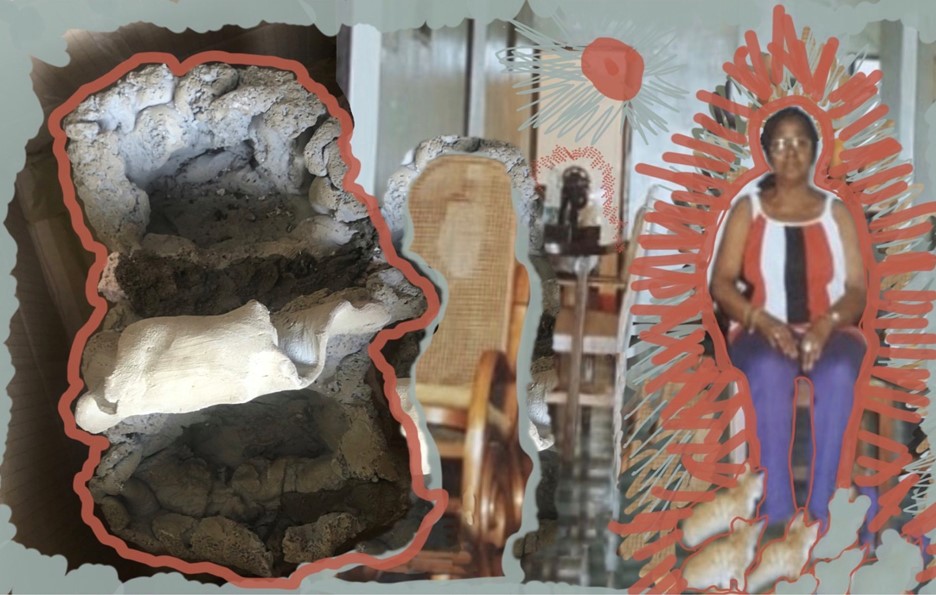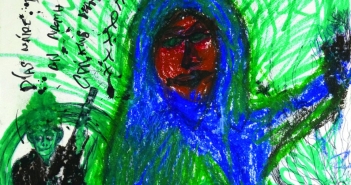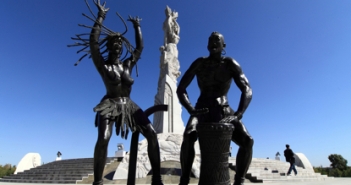Just off Nassau Street, a cavernous concrete passageway leads into the modernist Arts Building at Trinity College Dublin. The Douglas Hyde Gallery tucked neatly into its side is the current site of Family Lines, a major solo exhibition by Irish/Sierra Leonean artist Alice Rekab.
Within, they present a rich and resounding body of work that embraces many lifetimes and life forms. The artist explores and reflects on personal and cultural narratives emerging from their mixed-race identity, uncovering and transforming traces of violence, both private and historical, through multiple mediums, terrestrial and digital.
Upon entrance a video/installation entitled Migration Sings (2020) tells the story of the movement of peoples as well as the impact of the Atlantic Slave Trade on Sierra Leone.
Performed in the language of Temne (a Niger-Kordofanian language, West Atlantic group, spoken in central Sierra Leone), lilting tones accompany an animated family photograph on a vertical screen. It includes their grandmother, known as ‘Teta’, just after her evacuation from Freetown following the civil war in the 1990s.
The importance of the family, especially the matriarch carries through the exhibition and the voice of the Khalilu Gibrill Daneil Conteh floats like a spell over the entire gallery.
The balcony walkway offers an overview of the main ground floor, and the space generously opens on descent, presenting itself as an arena that allows relationships between artworks to emerge.
Drawn to the installation in one corner of the gallery, a monitor displays footage of ‘Nomoli’ and prints of ritual and tribal ceremonies are grouped with talismanic figurines. The Nomoli were used to mark seams of precious minerals in the ground; deposits that have been extracted and exploited for centuries.
The symbolic sculptures made of soft stone are the only known remains of an empire that stood hundreds of years ago. Josephine Kargbo, the curator of collections at the Sierra Leone National Museum in Freetown, explains that although she has never seen any of their power manifest, she does not rule out their potency.
This work sets the pulse of the exhibition; it is difficult not to be gripped by the pain and horrors suffered by Teta – to feel that this trans-generational work is somehow healing a deep wound that has been uncovered, just as fissures marked by the Nomoli were. As stated by Bracha Ettinger, “we join in sorrow so that silenced violence will find its echo in our spirit, not by imagination but by artistic vision.”
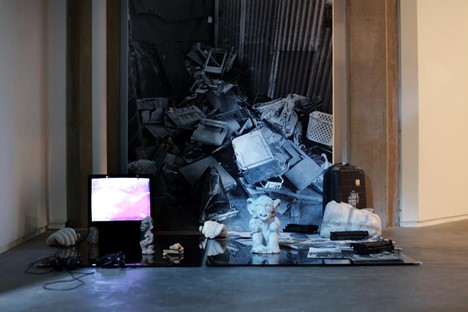
What is Nomoli? 2022 Archive Version, 2018-2022, Black and white video (12 mins), Sony cube monitor, stone figure, pottery tools, painted clay, tinted mirrors, black prints and enlarged iPhone photograph on vinyl (210 cm x 168 cm). Work commissioned by Kingston University of London. Image credit; Senija Topcic 2022.
Placed along the main wall Our Common Ancestor (Five panels of enmeshed historical narrative, 2022, Paint, oil pastel, salvaged wooden boards, clay and digital prints) presents what appears as a series of scars cutting across the panels and terminating in what could be a lightning bolt, meteorite strike or even the primordial beginning of time.
Could this represent a fissure in the Sierra Leonean earth, one that yielded the blood diamonds that have fuelled the bitter civil war? Opposite, a mirror spawns tentacles that overstep the gallery boundaries. Seen (2019 -2022, Buff and terracotta clay, salvaged wooden board and salvaged mirror) places our selfie loving imago in a precarious position. We do not go unnoticed – we are framed, enveloped, while staring into the portal of another world.
A painting by the artist’s mother, Louise Meade, and an accompanying print by the artist, hang on an otherwise blank wall of the main level, while Samir’s Prism, (2021, Print of digital drawing, collage and family photo), Finds Mine (2021 digital print) and Analogue Mining (2020, digital print, buff and terracotta clay, plasticine and book) exemplify a long experience of being defined, classified and confined through the interpretation, oppression, and values of the colonialist system.
Shapeshifting artifacts inhabit the gallery floor – displaying a group of tables, a distinctly anthropomorphic commode, some hot-blooded reptiles with babies and a vintage vacuum cleaner that has mutated into a snake.
Made from unfired clay, the objects are parched and bone dry. Imprints of the artist’s fingers show an intimacy, malleability and an amount of patience that reflects drought-stricken Sierra Leonean farmers’ unrelenting belief in the spirit world and the promise of a good harvest.
There is a strong sense of dignity, love, and resilience. A monumental print of a clay pit reminds us of our vulnerability and insignificance in an untameable place, as fantasy, memory and fact collide (Fig 3).
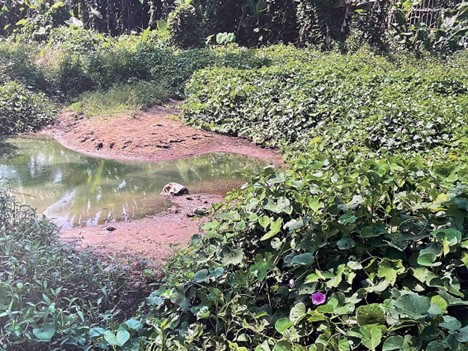
Nyaguihun Gateway (clay swamp near Bo), 2022, Enlarged iPhone photo on vinyl, 335 cm x 406 cm.
Turning towards Christmas on Cemetery Road/Hamilton (2021/2022) the video feels intimate, familiar, personal, and magical. As viewers, we are eager to accompany this exploration of interior and exterior space, discovering new sights as imagery moves on into the hot African night.
Family Lines generates resonant energy, which ought to be observed gently, over time. This exhibition offers an opportunity to witness an encounter with ‘self’ that is deeply embedded in subconscious experience.
The artist’s exploration of their own identity generates a form of healing. Their art-space uncovers traces of trauma which enable the rebuilding of trust in the other, which in turn adjusts their and our position in the world.
As we observe this process, some of us may feel compassion, awe and a sense of shared responsibility. We are a part of this history and the legacy of colonialism. We might realise that the real value found in the earth is not diamonds, gold, or iron ore – but in the ground itself – and the respect required to let it be, in the hope of yielding a harvest that can nourish a family.
Alice Rekab: Family Lines
Douglas Hyde Gallery, Dublin.
1 July- 25 September 2022
Feature Image: Isata an Ee Cat, 2018, Print of digital drawing, collage and family photo, 107.5cm x 151 cm. An edition of this work is in the Collection of the Irish Museum of Modern Art, Purchased 2021.

